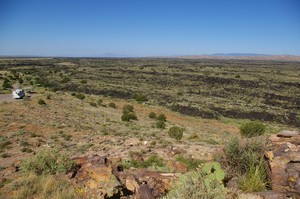 Leaving Brantley, we have a little over a week to get to the Salt Lake area for Sterling’s appointment to assess whether he’s a candidate for the microsurgery on his Achilles. We decide we deserve a holiday and so plan our route accordingly. It looks a little like a trip down memory lane.
Leaving Brantley, we have a little over a week to get to the Salt Lake area for Sterling’s appointment to assess whether he’s a candidate for the microsurgery on his Achilles. We decide we deserve a holiday and so plan our route accordingly. It looks a little like a trip down memory lane.
Our first stop is at Valley of Fires, a BLM recreation area on the edge of the Malpais lava flow, close to the tiny settlement of Carrizozo, New Mexico. We came here about twelve years ago and while we feel fondly of the place, our memories of the campground are hazy. Sterling can’t remember it at all and I have a memory that proves completely wrong. We choose a site and on checking our database realise that we’re in the same site as on our previous visit. I like to think we always have impeccable taste but maybe we’re just very predictable.
 After the feeling of being confined to a very small space for weeks, the wide open landscape is somehow a relief, as though we’ve been set free. The bleached grasslands give way to the dark lava-field coated in its pale mantle of vegetation, the mountains framing the valley off on the horizon. It’s a place for staring off into the distance, losing oneself in the colours, absorbing the silence and beauty.
After the feeling of being confined to a very small space for weeks, the wide open landscape is somehow a relief, as though we’ve been set free. The bleached grasslands give way to the dark lava-field coated in its pale mantle of vegetation, the mountains framing the valley off on the horizon. It’s a place for staring off into the distance, losing oneself in the colours, absorbing the silence and beauty.
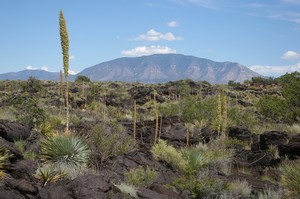 A short paved nature trail out across a section of the lava field is within Gimpy’s ability and offers the delights of up-close lava formations, vegetation thriving in unlikely looking niches and lizards aplenty.
A short paved nature trail out across a section of the lava field is within Gimpy’s ability and offers the delights of up-close lava formations, vegetation thriving in unlikely looking niches and lizards aplenty.
In our on-going quest for towns for our A list we stop in Socorro. We’ve visited the town previously but this time it’s with a view to assessing it as a potential place to live. It’s a small historic town with a tastefully developed downtown area, and the obvious benefits of being a university town.
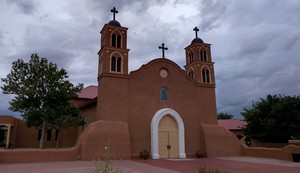 We visit the mission, wander the streets and drop into a new brewery, Twisted Chilli, which is located in the original building occupied by the Socorro Brewing Company (SBC) that we visited back in 2004. Obviously, a town with two brew-pubs is likely to score a few extra points. We’ve carried a growler from the SBC since our first visit and have had it filled at numerous locations over the years. We’re not overly impressed by the new brewery and the soft spot we have for the SBC remains unrivalled. For various reasons the town doesn’t make the A list but no doubt we’ll visit again at some point.
We visit the mission, wander the streets and drop into a new brewery, Twisted Chilli, which is located in the original building occupied by the Socorro Brewing Company (SBC) that we visited back in 2004. Obviously, a town with two brew-pubs is likely to score a few extra points. We’ve carried a growler from the SBC since our first visit and have had it filled at numerous locations over the years. We’re not overly impressed by the new brewery and the soft spot we have for the SBC remains unrivalled. For various reasons the town doesn’t make the A list but no doubt we’ll visit again at some point.
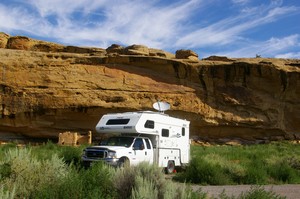
Chaco Culture National Historical Park is our next stop. Last time we stayed here it was in a tent before the thought of full-timing changed our lives. The road in is forty miles of dirt track with its fair share of wash boarding just to add to the fun.
Sandstone cliffs mark one side of the campground, the remains of small ancestral Puebloan buildings tucked into the lee of the wall. While the setting is attractive enough, the campground layout isn’t great. The sites are too close together and given it’s nowhere near full, even on a weekend, it seems that a bit more breathing space could have been allowed. The campground proves entertaining in its own right when in the aftermath of a torrential rain, water pours off the cliffs in impressive volume, developing into streams that flow across various campsites. We’re grateful not to be in a tent.

Chaco is a major ancestral Puebloan center dating from the mid-800s. It was inhabited and developed for three hundred years before the people left. It consists of various great houses: multi-storied complex structures for shelter and storage along with their associated circular Kivas for ceremonial purposes. The extent of what remains hints at the sophistication of the people who lived here and the site remains sacred to the peoples of many Native American tribes who trace their ancestry to this location. There are tensions today between the National Park Service who are tasked with preserving the site whilst allowing public access and some tribes who believe that the site should be closed and left to return to the earth.
We cycle from our campsite around the park loop road, taking various short trails to the different sites. The size and complexity of these structures is amazing, the stone hewn from the local rock give the finished buildings a harmony with their surroundings, an appearance of melding with their environment. There is something very special about standing where people stood so long ago, about feeling a connection with the past and sensing the transience of our own footprints.

The influence and presence of the ancestral Puebloan culture is evident throughout the south west and we leave Chaco to visit Aztec Ruins National Monument. The name is a misnomer dating from a belief that these sites belonged to ancestors of the Aztecs. It somehow seems strange that the site has not been renamed but then maybe it’s a challenge to come up with an appropriate name that’s acceptable to the numerous tribes who trace a connection to this place.
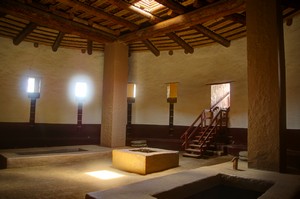 Aztec Ruins is not on the scale of the Chaco Culture site but has a number of distinct attractions of its own. The first is something that the park service would never countenance today, a reconstructed kiva. The great kiva at Aztec Ruins was first excavated in 1921 by Earl Morris who went on to reconstruct it in 1934. It is the largest reconstructed building of this sort, with a diameter of over forty feet. While it may be out of keeping with today’s approach to these sites, it is nevertheless an aid in imagining it, full of the throngs of people who would have gathered here for communal or ceremonial events.
Aztec Ruins is not on the scale of the Chaco Culture site but has a number of distinct attractions of its own. The first is something that the park service would never countenance today, a reconstructed kiva. The great kiva at Aztec Ruins was first excavated in 1921 by Earl Morris who went on to reconstruct it in 1934. It is the largest reconstructed building of this sort, with a diameter of over forty feet. While it may be out of keeping with today’s approach to these sites, it is nevertheless an aid in imagining it, full of the throngs of people who would have gathered here for communal or ceremonial events.
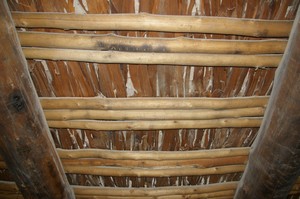 The second aspect of particular interest here are the relatively intact rooms at the back of the great house, some with their original ceilings. Supporting beams of large diameter pine or juniper are overlaid at right angles with smaller poles, in groups of three. Some ceilings are topped with willow matting lashed in place using yucca fiber, this layer preventing dust falling to the room below and all are finished off with juniper splints and a thick layer of tamped earth, forming the floor of the room above.
The second aspect of particular interest here are the relatively intact rooms at the back of the great house, some with their original ceilings. Supporting beams of large diameter pine or juniper are overlaid at right angles with smaller poles, in groups of three. Some ceilings are topped with willow matting lashed in place using yucca fiber, this layer preventing dust falling to the room below and all are finished off with juniper splints and a thick layer of tamped earth, forming the floor of the room above.
Our final stop is at Natural Bridges National Monument. We were here last, with my sister Solanna, in a rental RV not that many months before we originally took to the road. This is a comparatively isolated park with lower visitor numbers than the big name parks on the main tourist loop in this part of Utah. The small campground, nestled amongst the juniper and pinion, is a delight and makes for a wonderful few days at the end of this trip.
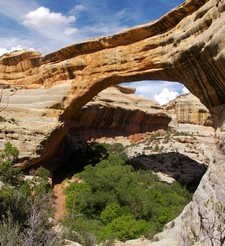 The three bridges for which the monument is named are best experienced from a variety of distances, from far off to up close and Sterling is determined to walk down into canyons for the up close and personal views. This is our last stop ahead of his assessment for the surgery and by this point he has thrown caution to the wind. The boots come out and off we go on the trail down to Sipapu Bridge. Not far along we hear someone calling for help and scanning the area below pick out a man on the opposite side of the canyon. He’s lost. Sterling stays put to keep him in sight while I go back up to get someone to go to the visitors center for help. The man’s wife is at the top, worried and tearful and I’m able to offer reassurance that he’s appears unhurt but can’t find his way back to the trail. I stay with her while we wait for the rangers to arrive. It’s a couple of hours before he finally makes it back to the top with the rangers. He’s not the youngest, fittest or best-equipped hiker we’ve ever seen and his wife tells me he has high blood pressure and a tendency towards heatstroke. He’d set off without map or water, had gone off trail and then couldn’t find his way back.
The three bridges for which the monument is named are best experienced from a variety of distances, from far off to up close and Sterling is determined to walk down into canyons for the up close and personal views. This is our last stop ahead of his assessment for the surgery and by this point he has thrown caution to the wind. The boots come out and off we go on the trail down to Sipapu Bridge. Not far along we hear someone calling for help and scanning the area below pick out a man on the opposite side of the canyon. He’s lost. Sterling stays put to keep him in sight while I go back up to get someone to go to the visitors center for help. The man’s wife is at the top, worried and tearful and I’m able to offer reassurance that he’s appears unhurt but can’t find his way back to the trail. I stay with her while we wait for the rangers to arrive. It’s a couple of hours before he finally makes it back to the top with the rangers. He’s not the youngest, fittest or best-equipped hiker we’ve ever seen and his wife tells me he has high blood pressure and a tendency towards heatstroke. He’d set off without map or water, had gone off trail and then couldn’t find his way back.
The following day we head out for a couple of short hikes, the second of which takes us down to Owachomo Bridge. It’s a typical southwestern day: bright blue skies, sunshine, warm temperatures, red rock and the varied greens of sage, juniper and pinon. No wonder Utah is one of our favourite states.
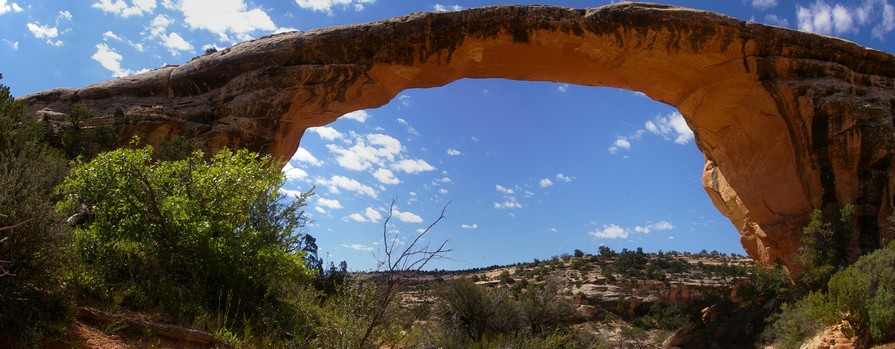
We drag ourselves away and into the Salt Lake valley metropolis for Sterling’s appointment. After x-ray and MRI the doc decides that Sterling is a suitable candidate for the Tenex procedure and the day surgery is scheduled two and a half weeks later. This means that we’re free to go off and enjoy ourselves for a while longer and we start looking at possibilities that evening.